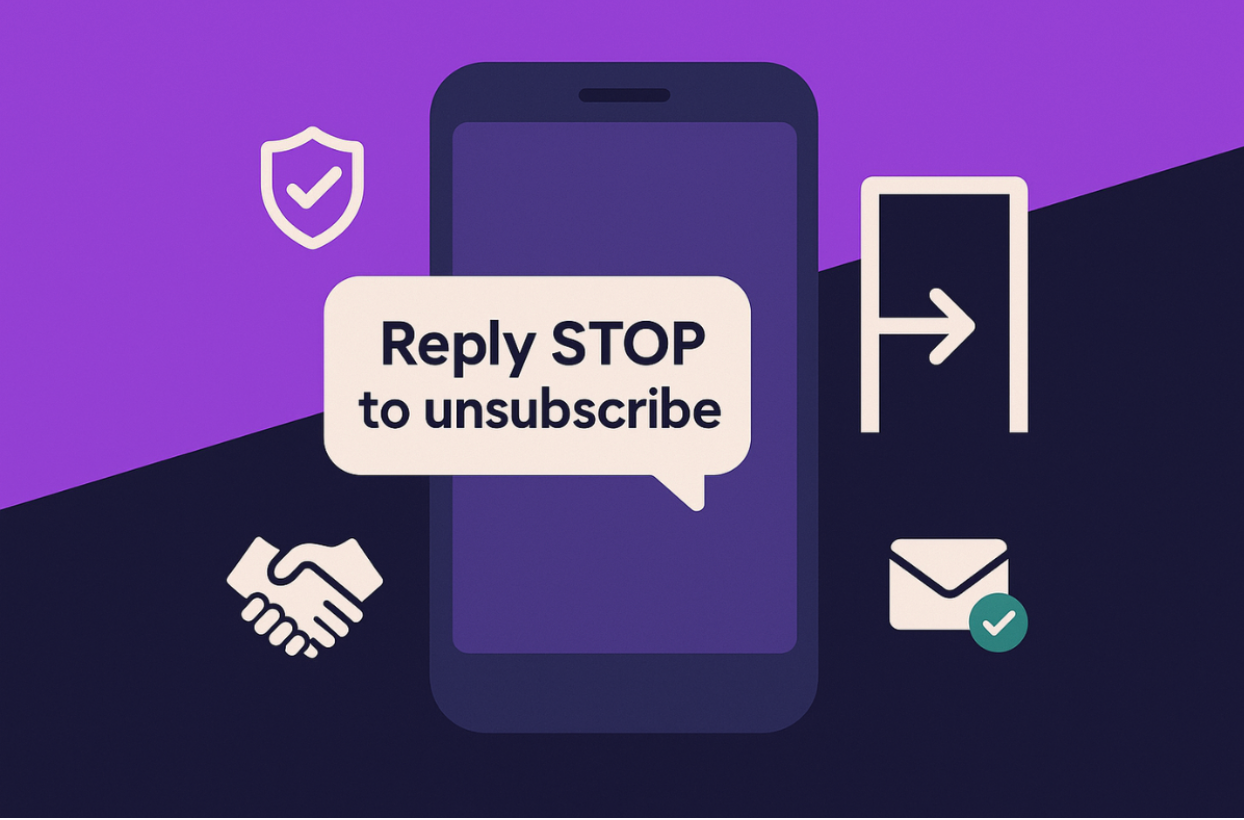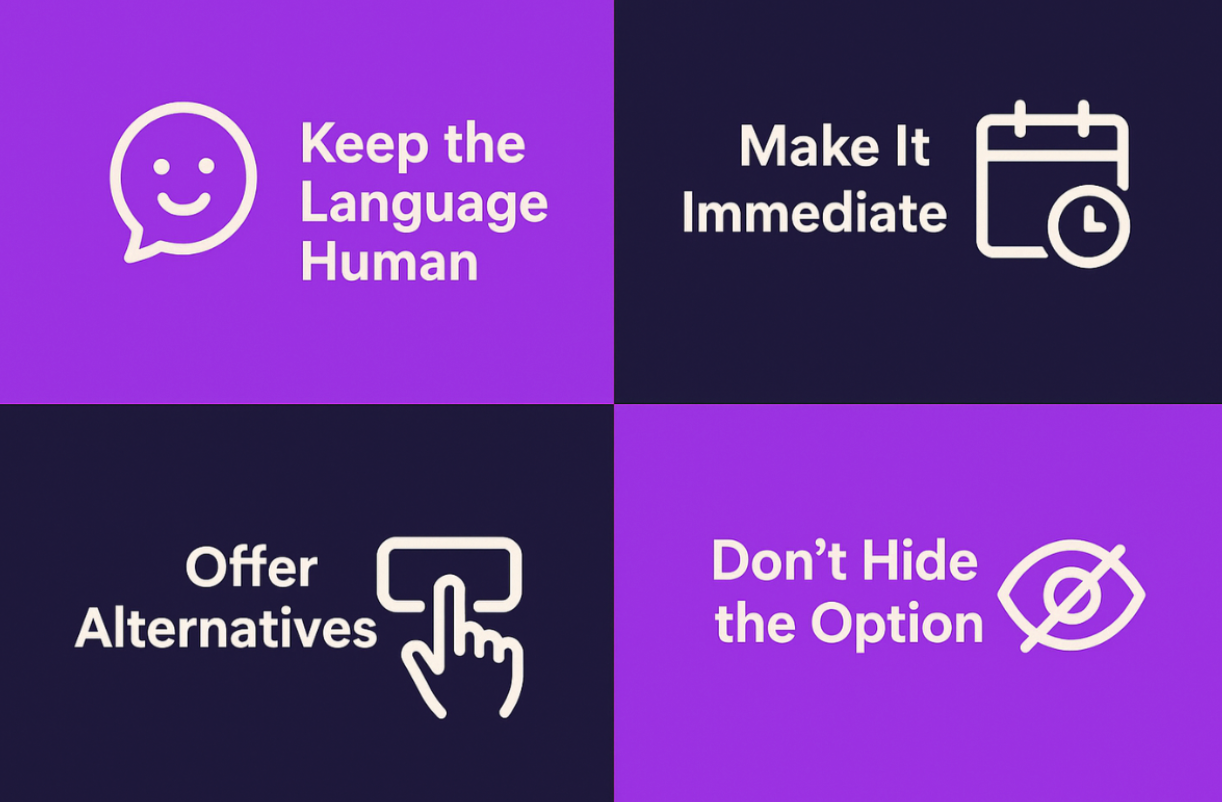November 21, 2025
5 minutes read
Opt-Out Messages: How to Respect Customer Choice Without Hurting Engagement

Customer trust is one of the most valuable currencies in business messaging. Yet, when brands send marketing messages without offering a clear, simple way to stop them, trust erodes quickly.
Opt-out messages are both a legal requirement in many regions and a sign of respect for customer preferences.
Done right, they allow people to step away without frustration, while keeping the door open for future interaction.
Done poorly, they can push customers away for good. This guide explores how to design opt-out messages that meet compliance standards, respect privacy, and still support long-term engagement.
Why Opt-Out Messages Matter More Than You Thin
The goal of an opt-out message isn’t to “lose” a customer. It’s actually to give them control over the relationship. Think of it as providing an emergency exit in a crowded room: people may not always use it, but knowing it’s there makes them feel safer staying.
When brands avoid offering a clear unsubscribe option, they risk:
- Violating regulations like TCPA, CAN-SPAM, or GDPR.
- Damaging their sender reputation with carriers and platforms.
- Losing trust, leading to higher complaint rates and customer churn.
An effective opt-out process shows customers they’re valued enough to make their own decisions. In many cases, that respectful approach keeps them more open to re-engagement later.

The Balance: Compliance and Connection
The challenge lies in making opt-out options clear without actively encouraging disengagement. For example, an SMS opt-out message should be easy to spot but not dominate the conversation.
A balanced approach involves:
- Clear instructions on how to stop messages.
- A friendly, human tone that softens the transactional nature of the message.
- Strategic placement—end of the message, not the start.
Instead of:
Reply STOP to unsubscribe.
Consider:
Need a break? Reply STOP anytime to pause messages.
This tiny shift makes the instruction feel less like a command and more like an option. Over time, these small improvements compound, leading to healthier engagement rates across SMS marketing campaigns without increasing opt-out requests.
Crafting Opt-Out Messages That Keep the Door Open
An opt-out doesn’t have to be the end of the relationship. With the right tone and structure, you can give customers control while keeping the connection warm for future re-engagement.

1. Keep the Language Human
Avoid sounding overly technical or legalistic. A cold, compliance-only line can make your brand feel distant.
Example:Instead of “Text STOP to end messages,” try “Want fewer updates? Text STOP at any time.”
2. Make It Immediate
Once a customer opts out, the change should take effect quickly. Delays can trigger frustration and complaints.
3. Offer Alternatives
Sometimes, customers don’t want to leave entirely - they just want fewer messages or different content. Offering a preference center can turn a total unsubscribe into a partial one.
4. Don’t Hide the Option
Burying opt-out instructions in fine print is not only risky but signals to customers that you value retention over respect.
Pair Opt-Outs With Re-Engagement Strategies
Crafting respectful unsubscribe options is just one step when you try to create a successful SMS marketing campaign. Building in re-engagement strategies ensures you can win customers back without violating their preferences.
Every opt-out message can double as a future re-entry point. If someone leaves your SMS list, follow up via another channel (like email) with a one-time “We miss you” offer after a set cooling-off period.
Done right, this respects their choice while showing genuine interest in having them back. Just make sure you’re not violating any channel-specific rules or sending messages where you no longer have consent.
The Role of Technology in Managing Opt-Outs
Modern platforms can instantly flag numbers that reply “STOP,” update lists in real time, and ensure compliance across campaigns.
Using a reliable messaging API streamlines this process, allowing opt-out handling to integrate seamlessly with your broader communication systems.
For brands using bulk messaging, this is of the utmost importance. Manual tracking leaves too much room for error and non-compliance.
If you need to create an opt-out link for SMS, many platforms now offer tools that generate trackable links for preference management pages. This can reduce total opt-outs by offering granular options like “pause messages” or “receive only promotions.”
SMS Opt-Out Message Examples That Work

Looking for perfect opt-out messages for SMS that balance clarity and tone? Here are a few:
- “Reply STOP to end messages. Need fewer updates? Text PAUSE.”
- “Not feeling it? Reply STOP anytime—no hard feelings.”
- “Want to change how often we text? Reply HELP.”
Each gives the customer control without closing the relationship entirely.
Avoiding Common Mistakes
Even with the best intentions, some businesses create opt-out processes that unintentionally frustrate customers and damage long-term engagement.
- Making opt-out processes too complex. If the unsubscribe process requires multiple steps, log-ins, or navigating through unrelated pages, customers will likely view it as a deliberate barrier.
- Using unfriendly or abrupt language. A cold “STOP to unsubscribe” works functionally, but a warmer tone leaves the door open for future interaction. The language in an opt-out message shapes how a customer remembers the brand after leaving.
- Ignoring unsubscribe requests for days or weeks. Delayed processing risks sending more unwanted messages, which can feel disrespectful and lead to formal complaints. Real-time or near-instant processing is the gold standard.
- Removing customers entirely instead of offering reduced-frequency options. Some people don’t want to cut ties; they just want fewer messages or different types. Offering a “pause” or “preferences” option can convert an unsubscribe into a retention opportunity.
- Failing to confirm the opt-out. Sending a quick confirmation reassures the customer that the request went through and prevents confusion if they receive a stray message.
A streamlined, customer-first approach (fast, friendly, and flexible), often results in fewer total losses and a stronger brand reputation.
Respect Drives Retention
Offering clear, respectful opt-out messages is not about losing customers but rather about keeping the relationship honest. Customers who feel in control are far more likely to return when they’re ready.
When building your process, combine compliance with tone, speed, and alternative options.
And if you want the technical side handled properly, platforms like TopMessage provide built-in tools to manage opt-outs, track preferences, and support long-term engagement - without sacrificing compliance.
Respect the choice, protect the trust, and keep the connection alive.
FAQs
How do you opt out of messages?
The exact method depends on the channel. For SMS, replying with keywords like STOP or UNSUBSCRIBE usually works. For email, clicking the unsubscribe link is the standard. For app notifications, you’ll need to adjust settings in the app or device.
Can you opt out of group text messages?
Yes, most modern messaging platforms allow it. In many cases, leaving a group chat will stop further messages, but for automated campaigns, you’ll need to follow the official unsubscribe process.
Do opt-out messages affect deliverability?
Yes. Well-managed opt-out systems help maintain carrier trust and reduce the risk of being flagged as spam.
Should every marketing message have an opt-out?
If you’re operating in regions where it’s required, yes. Even where it’s not mandatory, it’s good practice for customer trust.
What’s the best placement for an opt-out message?
Typically, at the end of the message, where it’s visible but doesn’t overshadow the main content.
Can opt-out data be used for analytics?
Yes, tracking opt-out trends can reveal patterns in message frequency, content preferences, and campaign timing.